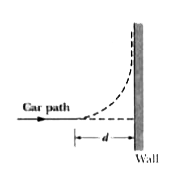Statement I: The driver of a moving car sees a wall in front of him. To avoid collision, he should apply brakes rather than taking a turn away from the wall.
Statement II: Frictional force is needed to stop the car or taking a turn on a horizontal road.
Statement I is true, statement II is true, Statement II is the correct explanation for statement I.
Statemet I is true, Statement II is true , Statement II is NOT the correct explanation for Statement I
Statement I is True, Statement II is False.
Statement I is False, Statement II is true
The correct Answer is:B
Force needed when breaks are applied
f1=ma=mv2d
(v: initial speed, d: distance from wall)
When turn is taken
F2=ma=mv2d
Hence breaks must be applied.
Topper's Solved these Questions
- BOOK - CENGAGE PHYSICSCHAPTER - NEWTON'S LAWS OF MOTION 1EXERCISE - Linked Comperhension46videos
NEWTON'S LAWS OF MOTION 1
- BOOK - CENGAGE PHYSICSCHAPTER - NEWTON'S LAWS OF MOTION 1EXERCISE - Integer5videos
NEWTON'S LAWS OF MOTION 1
- BOOK - CENGAGE PHYSICSCHAPTER - NEWTON'S LAWS OF MOTION 1EXERCISE - Multiple Correct11videos
NEWTON'S LAWS OF MOTION 1
- BOOK - CENGAGE PHYSICSCHAPTER - MISCELLANEOUS VOLUME 2EXERCISE - INTEGER_TYPE10videos
MISCELLANEOUS VOLUME 2
- BOOK - CENGAGE PHYSICSCHAPTER - NEWTON'S LAWS OF MOTION 2EXERCISE - Integer type1videos
NEWTON'S LAWS OF MOTION 2
Similar Questions
The driver of a car travelling at speed v suddenly sees a wall at a distance r directly infront of him. To avoid collision, should he apply the brakes or turn the car sharply away from the wall ? Give reason.
View SolutionThe dirver of a car travelling at a velcituy (v) suddenly sees a broad wall in front of mim at a distance r. Is it better to brake or to turn sharply ?
View Solution
Knowledge Check
- Question 1 - Select One
The driver of a car-travelling at speed V suddenly sees a wall at a distance r directly infront of him. To avoid collision. He should :
Aapply the brakesBturn the car simply away from the wallCdo any of the above optionsDnone of these - Question 2 - Select One
The driver of a car travelling at velocity v suddenly see a broad wall in front of him at a distance d. He should
ABrake sharplyBTurn sharplyC(a) and (b)DNone of the above - Question 3 - Select One
A car moving on a horizontal road may be thrown out of the road in taking a turn.
ABy the gravitational forceBDue to lack of sufficient centripetal forceCDue to friction between road and the tyreDDue to reaction of earth
A car driver going at speed v suddenly finds a wide wall at a distance r . Should he apply breakes or turn the car in a circle of radius r to avoid hitting the wall.
View SolutionBrake or turn? Figure depicts an overhead view of a car's path as the car travels toward a wall. Assume that the driver begins to brake the car when the distance to the wall is d=107 m, and take the car's mass a m=1400 kg, its initial speed as v0=35 m/s and the coefficient of static friction as μs=0.50. Assume that car's weight is distributed evenly on the four wheels, even during braking (a) What magnitude of static friction is needed (between tires and road) to stop the car just as it reaches the wall? (b) What is the maximum possible static friction fs,max/ (c) If the coefficient of kinetic frictic between the (sliding) tires and the road is μk=0.40, at what speed will the car hit the wall? To avoid the crash, a driver could elect to turn the car so that it just barely misses the wall, as shown in the figure. (d) What magnitude of frictional force would be required to keep the car in a circular path of radius d and at the given speed v0, so that the car moves is a quarter circle and then parallel to the wall? (e) Is the required force less than fs.max so that a circular path is possible?
 View Solution
View SolutionThe driver of a truck travelling with a velocity upsilon suddenly notices a brick wall in front of him at a distance d It is better for him to apply brakes or to make a circular turn without applying brakes in order to just avoid crashing into the wall ? Why ?
View SolutionThe driver of a car travelling with velocity v on a road suddenly sees a broad wall in front of him at a distance r. He has two alternatives: to turn sharply or a brake instantly. The passenger who is a professor of physics, advises him to brake to avoid collision.
Read the above passage and answer the following questions:
(i) How is the suggestion from Professor of Physics justified?
(ii)Does the suggestion work really?
(iii)What value do you learn from this experience?View SolutionWhen the driver of a car A sees a car B moving towards his car and at distance 30m, takes a left turn fo 30∘. At the same instant the driver of the car b takes a turn to his right at an angle 60∘. The two cars collides after two second, then the velocity (in m/s) of the car A nad B respectively will be :[assume both cars to be moving along same line with constant spped]
View Solution

